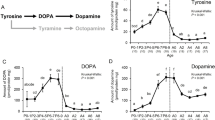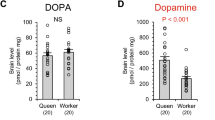Summary
Changes in biogenic amine levels associated with the morphological and behavioural development of the worker honeybee are examined.
A significant increase in amine levels in the head of the honeybee is associated with transition from the larval to pupal stage. Adult emergence is also accompanied by a significant increase in 5-HT levels in the brain, but no significant change in brain dopamine (DA) levels. NADA (N-acetyldopamine) levels increase during larval and pupal development, but in contrast to both DA and 5-HT, drop significantly during the transition from pupa to adult.
Levels of DA in the brain of nectar and pollen forager bees, presumed to be among the oldest adults sampled, were found to be significantly higher than in nurses, undertakers or food storers. These results suggest that an age-dependent change in amine levels occurs in the brain of the worker bee. In the optic lobes, levels of DA and 5-HT were found to be significantly higher in pollen forager bees than in all other behavioural groups. Significant differences in amine levels in the optic lobes of nectar foragers and pollen foragers indicate that some differences in amine levels occur independent of worker age. The functional significance of differences in brain amine levels and whether or not biogenic amines play a direct role in the control of honeybee behaviour has yet to be established.
Similar content being viewed by others
Abbreviations
- DA :
-
dopamine
- 5-HT :
-
5-hydroxytryptamine or serotonin
- NADA :
-
N-acetyldopamine
References
Andersen SO (1979) Biochemistry of insect cuticle. Annu Rev Entomol 24:29–61
Andersen SO (1985) Sclerotization and tanning of the cuticle. In: Kerkut GA, Gilbert LI (eds) Comparative insect physiology, biochemistry and pharmacology. Vol 3. Pergamon, Oxford, pp 59–75
Brandes Ch, Sugawa M, Menzel R (1990) High performance liquid chromatography (HPLC) measurement of catecholamines in single honeybee brains reveals caste-specific differences between worker bees and queens in Apis mellifera. Comp Biochem Physiol 97C:53–57
Breed MD, Robinson GE, Page RE (1991) Division of labor during honey bee colony defense. Behav Ecol Sociobiol 27:395–401
Brown CS, Nestler C (1985) Catecholamines and indoleamines. In: Kerkut GA, Gilbert LI (eds) Comprehensive insect physiology, biochemistry and pharmacology, Vol II, pharmacology. Pergamon Press, Oxford, pp 434–496
Brunet PCJ (1980) The metabolism of aromatic amino acids concerned in the crosslinking of insect cuticle. Insect Biochem 19:467–500
Calderone NW, Page RE (1988) Genotype variability in age polyethism and task specialization in the honeybee, Apis mellifera (Hymenoptera: Apidae). Behav Ecol Sociobiol 22:17–25
Calderone NW, Robinson GE, Page RE (1989) Genetic structure and division of labour in the honey-bee society. Experientia 45:765–767
Dewhurst SA, Croker SG, Ikeda, K McCaman (1972) Metabolism of biogenic amines in Drosophila nervous tissue. Comp Biochem Physiol 43B:975–981
Evans PD (1980) Biogenic amines in the insect nervous system. Adv Insect Physiol 15:317–473
Evans PH, Fox PM (1975) Enzymatic N-acetylation of indolealkylamines by brain homogenates of the honeybee, Apis mellifera. J Insect Physiol 21:343–353
Fluri, P, Lüscher M, Wille H, Gerig L (1982) Changes in weight of the pharyngeal gland and haemolymph titres of juvenile hormone, protein and vitellogenin in worker honey bees. J Insect Physiol 28:61–68
Free JB (1965) The allocation of duties among worker honey bees. Symp Zool Soc London 14:39–59
Frumhoff PC, Baker J (1988) A genetic component to division of labour within honeybee colonies. Nature 33:358–361
Fuchs D, Dustmann JH, Stadler H, Schürmann FW (1989) Neuroactive compounds in the brain of the honeybee during imaginai life. Comp Biochem Physiol 92C:337–342
Gary NE (1960) A trap to quantitatively recover dead and abnormal honeybees from the hive. J Econ Entomol 53:782–785
Jay SC (1962) Colour changes in honeybee pupae. Bee World 43:119–122
Jaycox ER, Skowronek W, Gwynn G (1974) Behavioral changes in worker honey bees (Apis mellifera) induced by injections of a juvenile hormone mimic. Ann Entomol Soc Am 67:529–534
Karlson P, Sekeris CE (1962) N-acetyl-dopamine as scleratizing agent of the insect cuticle. Nature 195:183–184
Karlson P, Sekeris CE, Sekeris KE (1962) Zum Tyrosinstoffwechsel der Insekten-VI. Identifizierung von N-acetyl-3,4-dihydroxy-B-phenäthylamin (N-acetyldopamin) als Tyronsinmetabolit. Z Physiol Chem 327:86–94
Macmillan CS, Mercer AR (1987) An investigation of the role of dopamine in the antennal lobes of the honeybee, Apis mellifera. J Comp Physiol A 160:359–366
Menzel R, Michelsen B (1986) Neuropharmacology of associative learning in bees. In: Matthies H (ed) Learning and memory. Mechanisms of information storage in the nervous system. Pergamon Press, Oxford, pp 273–275
Menzel R, Michelsen B, Rüffer P, Sugawa M (1988) Neuropharmacology of learning and memory in honey bees. In:. Hertig G, Spatz CH (eds) Synaptic transmission and plasticity in nervous systems. Springer, Berlin Heidelberg, NATO-ASJ, vol H19, pp 335–350
Mercer AR (1987) Biogenic amines in the insect brain. In: Gupta AP (ed) Arthropod brain: Its evolution, development, structure and functions. Wiley & Sons, New York, pp 399–414
Mercer AR, Erber J (1983) The effects of amines on evoked potentials recorded in the mushroom bodies of the bee brain. J Comp Physiol 151:469–476
Mercer AR, Menzel R (1982) The effects of biogenic amines on conditioned and unconditioned responses to olfactory stimuli in the honeybee Apis mellifera. J Comp Physiol 145:363–368
Mercer AR, Mobbs P, Davenport AP, Evans PD (1983) Biogenic amines in the brain of the honeybee (Apis mellifera). Cell Tissue Res 234:655–677
Michelsen DB (1988) Catecholamines affect storage and retrieval of conditioned odour stimuli in honeybees. Comp Biochem Physiol 91C:479–482
Moore AJ, Breed MD, Moore MJ (1987) The guard honey bee: ontogeny and behavioural variability of workers performing a specialized task. Anim Behav 35:1159–1167
Murdock LL, Omar D (1981) N-Acetyl-dopamine in insect nervous tissue. Insect Biochem 11:161–166
Owen MD, Bridges AR (1982) Catecholamines in honey bee (Apis mellifera L.) and various vespid (Hymenoptera) venoms. Toxicon 20:1975–2084
Owen MD, Sloley BD (1988) 5-hydroxytryptamine in the venom of the honey bee (Apis mellifera L.): variation with season and with insect age. Toxicon 26:577–581
Owen MD, Pfaff L, Sloley BD (1987) The absence of diel change in the concentrations of dopamine, 5-hydroxytryptamine and their metabolites in the cerebral ganglia of the cockroach, Periplaneta americana. Insect Biochem 17:723–729
Page RE, Robinson GE Genetic basis of division of labour in honey bee colonies. Adv Insect Physiol (In press)
Page RE, Robinson GE, Fondrk MK (1989) Genetic specialists, kin recognition, and nepotism in honey-bee colonies. Nature 338:576–579
Rehder V, Bicker G, Hammer M (1987) Serotonin-immunoreactive neurons in the antennal lobes and suboesophageal ganglion of the honey-bee. Cell Tissue Res 247:59–66
Robinson GE (1987a) Hormonal regulation of age polyethism in the honey bee, Apis mellifera. In: Menzel R, Mercer A (eds) Neurobiology and behavior of honeybees. Springer, Berlin Heidelberg New York, pp 266–279
Robinson GE (1987b) Regulation of honey bee age polyethism by juvenile hormone. Behav Ecol Sociobiol 120:329–338
Robinson GE Regulation of division of labor in insect societies. Annu Rev Entomol (in press)
Robinson GE, Page RE (1988) Genetic determination of guarding and undertaking in honey bee colonies. Nature 333:356–35
Robinson GE, Page RE (1989) Genetic determination of nectar foraging, pollen foraging and nestsite scouting in honeybee colonies. Behav Ecol Sociobiol 24:327–323
Robinson GE, Page RE, Strambi C, Strambi A (1989) Hormonal and genetic control of behavioral integration in honey bee colonies. Science 246:109–112
Sakagami SF (1953) Untersuchungen über die Arbeitsteilung in einem Zwergvolk der Honigbienen. Beiträge zur Biologie des Bienenvolkes, Apis mellifera L. I. Jpn J Zool 11:117–185
Schäfer S, Rehder V (1989) Dopamine-like immunoreactivity in the brain and suboesophageal ganglion of the honey bee. J Comp Neurol 280:43–58
Schürmann FW, Klemm N (1984) Serotonin-immunoreactive neurons in the brain of the honeybee. J Comp Neurol 225:570–580
Schürmann FW, Elekes K, Geffard M (1989) Dopamine-like immunoreactivity in the bee brain. Cell Tissue Res 256:399–410
Seeley TD (1982) Adaptive significance of the age polyethism schedule in honeybee colonies. Behav Ecol Sociobiol 11:287–293
Seeley TD (1985) Honeybee ecology: A study of adaptation in social life. Princeton University Press, Princeton, NJ
Sekeris CE, Karlson P (1966) Biosynthesis of Catecholamines in insects. Pharmacol Rev 18:89–94
Sekiguchi K, Sakagami SF (1966) Structure of foraging population and related problems in the honeybee, with considerations on the division of labour in bee colonies. Hokkaido Natl Agric Exp Sta Rep 69:1–65
Sloley BD, Downer RGH (1984) Distribution of 5-hydroxytryptamine and indoleaklylamine metabolites in the American cockroach, Periplaneta americana. Comp Biochem Physiol 79C:281–286
Sloley BD, Downer RGH (1987) Dopamine, N-acetyldopamine and dopamine-3–0-sulphate in tissues of newly ecdysed and fully tanned adult cockroaches (Periplaneta americana). Insect Biochem 17:591–596
Visscher PK (1983) The honey bee way of death: necrophoric behaviour in Apis mellifera. Anim Behav 31:1070–1076
Winston ML (1987) The biology of the honey bee. Harvard Univ Press, Cambridge, Massachusetts
Witthöft W (1967) Absolute Anzahl und Verteilung der Zellen im Hirn der Honigbiene. Z Morphol Tiere 61:160–184
Author information
Authors and Affiliations
Rights and permissions
About this article
Cite this article
Taylor, D.J., Robinson, G.E., Logan, B.J. et al. Changes in brain amine levels associated with the morphological and behavioural development of the worker honeybee. J Comp Physiol A 170, 715–721 (1992). https://doi.org/10.1007/BF00198982
Accepted:
Issue Date:
DOI: https://doi.org/10.1007/BF00198982




